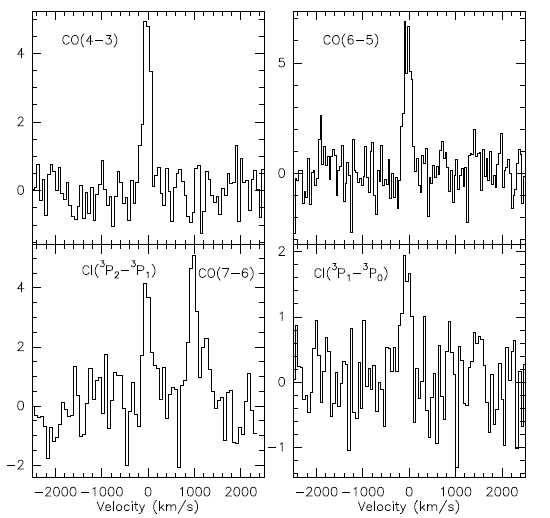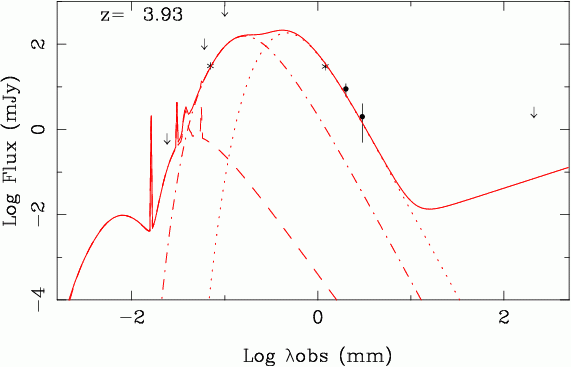An european team, led by a researcher from Paris Observatory, mapped a region of half a square degree with the IRAM-30m bolometer, searching for dust emission in a possible debris disk around a nearby star, at 1.2mm wavelength. They found a bright source in the field, so rare that the probability to find it was less than 7%. Since this source had no obvious optical counterpart, they thought of a hidden young stellar object, enshrouded by a possible cloud of molecules and dust. The young stars still embedded in their gas and dust cocoon, are indeed revealed only by their millimetric emission of the dust they heat. In this hypothesis, there should exist a nearby cloud of molecular gas, in which the emission lines of the CO molecules is the tracer easiest to detect. The search of CO lines with the KOSMA 3-meter telescope was unsuccessful. There does exist a dust source, but no nearby (unshifted) molecules. The team then undertook an exciting search for a very remote (redshifted) galaxy, that could be a very luminous object in the early universe. Molecular lines in the millimeter domain are one of the best mean to find the redshift, and therefore the distance and nature of such an object. The search was made possible thanks to a sophisticated receiver with a wide bandwidth (EMIR), newly installed at the IRAM telescope, allowing almost 8 GHz instantaneous width. In such a large frequency interval, it is not unlikely to find one of the rotational lines of the CO molecule. The spacing between successive lines is even reduced by the redshift, making the search more easy. However the detection of at least two lines are required for any identification. The search started with a scan of the whole 3 mm band, which requires 5 tunings of 2hours integration each. The astronomers were lucky enough, and found a first line after only 20 minutes integration during the 3rd tuning. At this stage, they made hypotheses about which CO line had been detected, and inferred what was the optimal tuning at higher frequency to confirm and definitely determine the redshift. The first line was the CO(4-3) and the second the CO(6-5) (see Figure 1). An accurate value of the redshift was then obtained : z = 3.92960 ± 0.00013. Finally, three CO lines and two lines of atomic carbon have been detected.

The analysis of the spectral energy distribution (cf Figure 2) shows that the bulk of the dust is heated at Tdust = 45K. From the observed CO lines, the mass of the gas is derived between 1.9 and 11x1011 . This value is much larger than what is expected for a galaxy, therefore it likely results from a large amplification by a lens. The moderate CO line excitation allows to exclude a dominant heating by nuclear activity (i.e. accreting black hole).

Follow up observations at high spatial resolution are now in order to search for multiple images and signatures of lensing, to better characterize this exceptional source MM 18423+5938. According to the amplification factor, the source could be a simple Luminous Infrared Galaxy (LIRG), like the interacting galaxies "The Antennae", in Figure 3a, or an Ultraluminous Infrared Galaxy, like the merging system Arp 220, in Figure 3b, or an hyperluminous sub-millimeter system. We can expect that the object splits into several gravitational images, like the Cloverleaf quasar, of Figure 3c, or is blown out in an Einstein ring, cf Figure 3d.

Reference Discovery of an Extremely Bright Sub-Millimeter Galaxy at z=3.93 J.-F. Lestrade (Obs-Paris), F. Combes (Obs-Paris), P. Salomé (Obs-Paris), A. Omont (IAP), F. Bertoldi (Bonn), P. André (CEA), N. Schneider (CEA) Astronomy and Astrophysics, accepted for publication Contact Jean-Francois Lestrade (Observatoire de Paris, LERMA et CNRS)
Francoise Combes (Observatoire de Paris, LERMA et CNRS)
Philippe Salomé (Observatoire de Paris, LERMA et CNRS)
